Arkansas’s Faulty Plan to Build a Mega Prison
And the community that exposed it
By Caroline McCoy

Photo courtesy of author
When they talk about Mill Creek Mountain, a rocky summit just south of the Arkansas River, the people of Franklin County tend to use a certain linguistic shorthand. Up there, they say, the same families have run cattle for generations. Up there, water is as precious as privacy. Up there, people raise and hunt their own food. They know how to can pretty much anything. Up there, kids uncover relics—sharks’ teeth that date to the Paleozoic Era and arrowheads shaped when the land belonged to the Osage and the Cherokee. (The Chickamauga Nation has also said that their ancestors inhabited and were buried on Mill Creek Mountain.)
As a descriptor, it’s deceptive. “Up there” does not capture height or steepness. No great peaks sprout from the horizon and signal the potential for climbing. (The elevation of Mill Creek Mountain is roughly 860 feet above sea level.) Rather, the phrase suggests a ruggedness of living characterized by a lack of modern infrastructure. Up there, the ground is uneven and dominated by solid rock, so residents don’t bury their septic tanks. Up there, the county water supply is so limited that most households depend on wells. It takes about thirty minutes to get an ambulance up there, because there are only two in the county. “If one’s broken down, or if they’re busy on the other side of the river, it might be an hour,” said Shannon McChristian, who grew up on Mill Creek Mountain. Her brother, former Justice of the Peace Cody Sosebee, said, “We can’t explain to everybody why we want to live like this. There’s no Uber. There’s no DoorDash.” Police in the county don’t work after midnight.
On October 31, 2024, “up there” became a concern for the citizens of Franklin County. At noon, the Governor of Arkansas, Sarah Huckabee Sanders, went live on a local country radio station, 92.7 FM, to announce the state’s purchase of 815 acres on Mill Creek Mountain. The site, a rolling swath of grassland cut through by a creek that feeds the local wells, had belonged for years to a cattle rancher named Toby Breeden. In 2021, he sold the property to a young couple, but everyone still referred to it as the Breeden ranch. Neighbors hadn’t known that the place was back on the market because the couple listed it with a real estate company based in Searcy, a hundred and fifty miles away. No “For Sale” signs ever went up. So it surprised the citizens of Franklin County to learn that the property was now under state ownership, freshly purchased for $2.95 million. This land, Sanders said, would be the site of Arkansas’s largest correctional facility, a 3,000-bed prison that would accommodate the state’s swelling inmate population and permanently employ nearly eight hundred people. “It’s . . . one of the most secluded locations that we could find,” Sanders said. “But while still not being right in the center of any community, but being close enough that it has the workforce that will be needed.” Locals who heard the announcement in real time balked. In fact, twenty-nine tax parcels share a fence with the property in question—a number that represents both single-family and multigenerational households. Six hundred and five families live within five miles of the site.
People began calling their friends and family members to spread the news. They posted about it on Facebook. Incredulousness was the general reaction: Up there? Carl Underwood, who was the principal of the elementary school in nearby Charleston for three decades, said that, at first, he and his wife, Rosemary, doubted what they were hearing. They live two and a half miles from Mill Creek Mountain and understand the infrastructure and population challenges the area would present to a project of such magnitude. The only roads for miles are rural single-lane highways and gravel connectors. There’s no sewer system in the region. Water is such a persistent issue that poultry farmers have been denied water permits. The prison would house a population larger than that of Charleston, the county seat in Franklin’s southern district; and the local unemployment rate is only 3.4 percent, low by any metric. Simply staffing the place seemed like an insurmountable hurdle. “I thought, ‘You can’t believe everything you read on Facebook,” Underwood said. “Who’s gonna build a prison up on Mill Creek Mountain?”
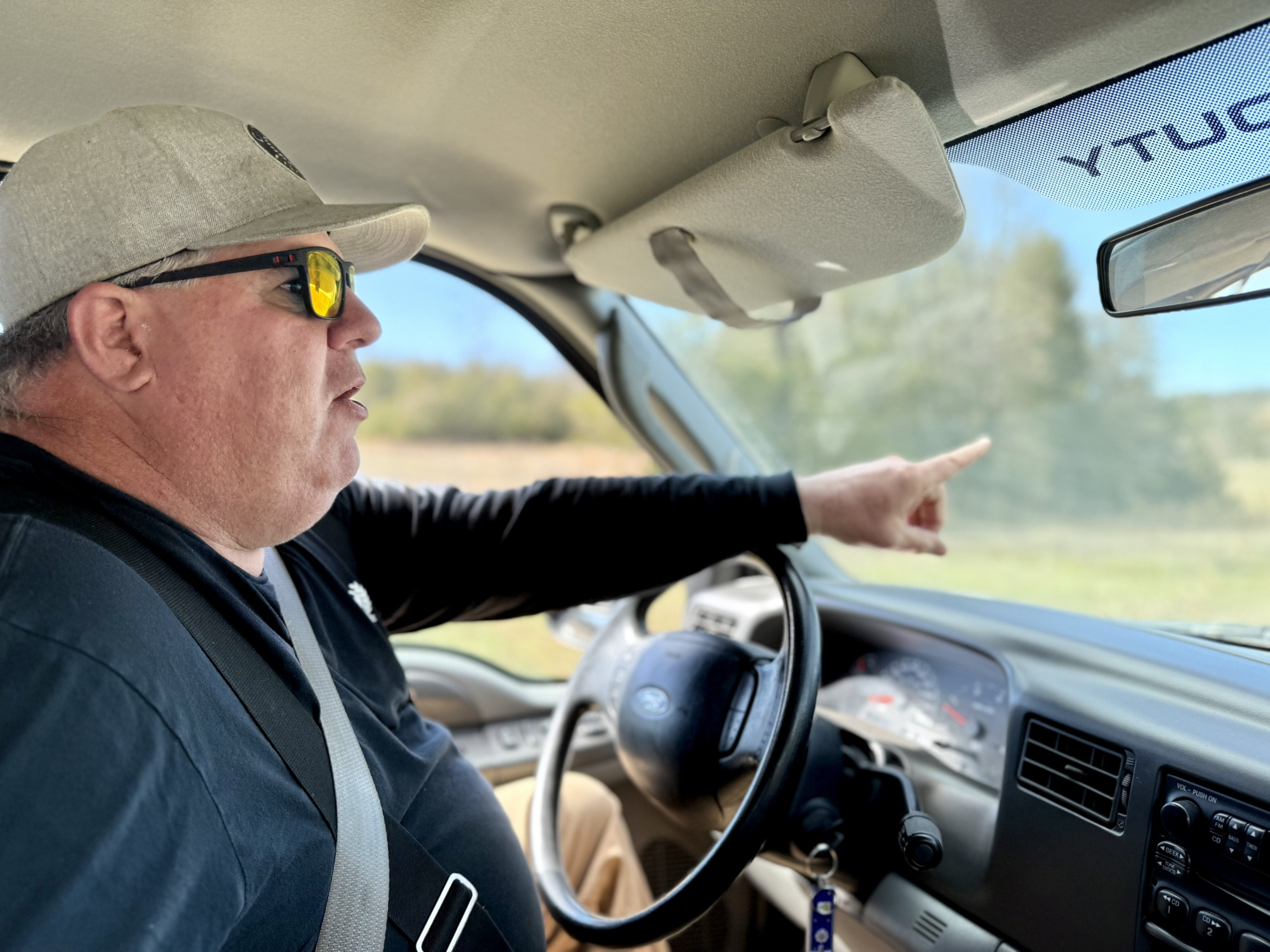
Cody Sosebee, who served as Justice of the Peace for Franklin County during the state’s purchase of the land, said that no one communicated with him or other local officials. Photo courtesy of author
When the truth settled into the close-knit farming community, disbelief gave way to anger. Within hours, the people of Franklin County began contacting their local officials, in part because the governor had implicated them in the prison site selection. During her announcement, Sanders said that her team had communicated with local stakeholders. “As we’ve made additional steps and made progress,” she said, “we made notification outreach to those stakeholders, and we’re going to continue to work with them throughout this process.” Sosebee, who was nearing the end of his six-year term as Franklin County’s Justice of the Peace, began receiving angry messages from his constituents and fielding questions from the courthouse lawn in Charleston. He swore to everyone who asked that he had learned about the prison during the Governor’s announcement, though some locals remained skeptical. “I was like, ‘You live with me. We go to ball games together. We go to church together,’” he said. His sister, Shannon McChristian, told me that Sosebee “took a lot of flack that first week, because everybody was like, ‘You had to know about it.’ . . . But nobody knew.”
The next day, Sosebee joined Senator Gary Stubblefield, of Branch, and County Judge Rickey Bowman on 92.7 FM to further correct the record. Stubblefield said that he had been “kept in the dark” until two days before the governor’s announcement. “The whole thing was just not done right,” he said, emphasizing that his constituents had been denied a voice in the state’s decision. Bowman said that the state had not consulted him or anybody else from Franklin County about the site selection. “No one knew about this,” he said. “I got the call at about three o’clock Tuesday afternoon. I was floored.” Sosebee, who grew up on a three hundred-acre horse and cattle ranch that abuts the prison property, became emotional when he spoke of his father, Don, who still runs the land at eighty-two years old. “Nobody, nobody wants that,” he said of the prison.
In short order, it became clear to the citizens and officials of Franklin County that other key stakeholders—namely the utility companies and emergency personnel that service the region—had not been consulted before the state purchased the land. A key point of the governor’s October 31 announcement had been the suitability of Franklin County and Mill Creek Mountain for a 3,000-bed prison. “A lot of the existing infrastructure needed for a location of this size were already there, and that was one of the reasons that this was such a great spot to be able to put this facility,” Sanders said. An accompanying press release issued by the governor’s office explained in more detail: “This parcel offers the infrastructure needed for a new prison, including cell reception, water lines, electricity, and a nearby fire department, and is also close to more than 100,000 workers who could staff the new facility.”
Locals were quick to note that, while fire-fighting resources are “nearby”—about two and a half miles from the prison site—“fire department” is a stretch of the imagination. The single-story building, trimmed in red paint but otherwise unmarked, sits across from the Baptist Church in the township of Vesta and houses two pickup trucks outfitted with plastic water tanks. Fire departments around the country are rated by the Insurance Services Office (ISO) on a scale of one through ten, with Class-1 departments representing top-tier fire protection and Class-10 departments indicating an inability to meet a community’s basic fire-safety needs. The closest ISO Class-1 department is in Fort Smith, twenty-nine miles and forty-five minutes away from the prison site. The “nearby fire department” in Vesta is unrated by the ISO. Rick Covert, who oversees Franklin County’s Office of Emergency Management, did not respond to my requests for comment, though Cody Sosebee, who worked with Covert during his tenure as Justice of the Peace, said, “He didn’t hear anything either.”
Brandon Fisher, the Director of Technology and Communications for Valley Electric Cooperative Corporation (AVECC), the company that would be responsible for providing broadband and electricity to the prison, according to the state’s official site assessment, said via email that no communication between the state and AVECC occurred prior to the governor’s announcement. Fisher wrote that, once the company heard about the state’s plans, “We did reach out to them, letting them know that we are eager to see any electrical specs that we will need to provide power to the proposed prison.” To date, no specs have been submitted to AVECC.
State officials had also neglected to consult the local water company, RiverSouth Rural Water District, prior to the land purchase. Jack Wells, the system manager for RiverSouth, said that no state representative had contacted the company in the months since the announcement either, which has prevented planning for system upgrades. “We have not had one inquiry about how this would work,” Wells said. “So we’re . . . just kind of sitting here waiting for [the state] to make the first move.” The average inmate uses between 120 and 149 gallons of water per day. Without factoring in usage among staff, that equates to between 360,000 and 447,000 gallons per day for 3,000 inmates. Wells told me that the projected usage for the site is almost twice the current supply. “You’re basically doubling our system, and our system is just not set up for that,” he said. “It doesn’t have the pipe size, it doesn’t have the pumping capacity, it doesn’t have the storage space, it doesn’t have any of that.”
The RiverSouth water treatment plant is roughly seventeen miles west of the prison site, just south of the bridge from Ozark, where the water originates. The plant is a noteworthy landmark for those who live south of the river, where chicken and cattle farms dot the rolling terrain. Locals swap stories about their taps running dry during hot summer months, about supplementing their farmland with well water. When the temperature drops and residents drip their faucets to prevent pipes from freezing, they consider the impact on the tanks that serve their rural area. According to Wells, the district upgraded two years ago by tying on to a line fed by neighboring Sebastian County. In July, August, and September, RiverSouth buys a surplus of water from this source to serve customers at the southwestern end of the waterline, where resources regularly dry up. Ted Kengla, who operates a poultry farm about ten miles south of Mill Creek Mountain, ran out of water so frequently that he constructed his own tower, where he collects rainwater to use as backup. Wells told me that several other poultry farmers have been denied water permits entirely because the standard supply from Ozark and supplemental supply from Sebastian County cannot meet the demands of new chicken houses.
Though RiverSouth services a portion of Mill Creek Mountain via four-inch PVC piping, most of the area households rely on wells and ponds for their farming operations. In some cases, residents have no access to county water. Cody’s father, Don Sosebee, who has spent most of his adult life on Mill Creek Mountain, has two wells on his property, the most bountiful of which sits at a lower elevation, downstream of Onion Creek, which runs through the prison site and serves as a primary source for many of the area’s wells. Sosebee’s wells are the only water sources for his three-hundred-acre property. “I haul a lot of water every day,” he said. How much depends on the amount of company he has, how much washing his wife Bonnie “Bo” needs to do. “Sometimes, I have to haul two loads a day. That’s five hundred gallons.”
Because no one has furnished a plan for the prison water supply, locals have begun exchanging theories. Some have considered the possibility that a reservoir will be constructed to exclusively serve the prison. Some believe doing that would mean damming Onion Creek, which would impact supply to the area’s wells. Most of the people I spoke with think that the state will try to draw water from Fort Smith, thirty miles away. Wells said this option would likely be costly and could present ethical problems. “We kind of have boundaries out there,” he said. He told me that laying down eight miles of twelve-inch PVC piping for the Sebastian County line extension project cost roughly $1.7 million, but he could not estimate the cost of infrastructure improvements for the prison site—or their impacts on residential water supplies—without understanding the needs of such a facility. “It may be worse. It may be better,” Wells said. “I don’t know until studies are done and we have actual figures.” The fact that no studies have been presented to the public only raises more questions for the people of Franklin County. Wells said that without communication from the state, he could offer no answers. “The way we sit right now,” he told me, “there’s no way it would work.”
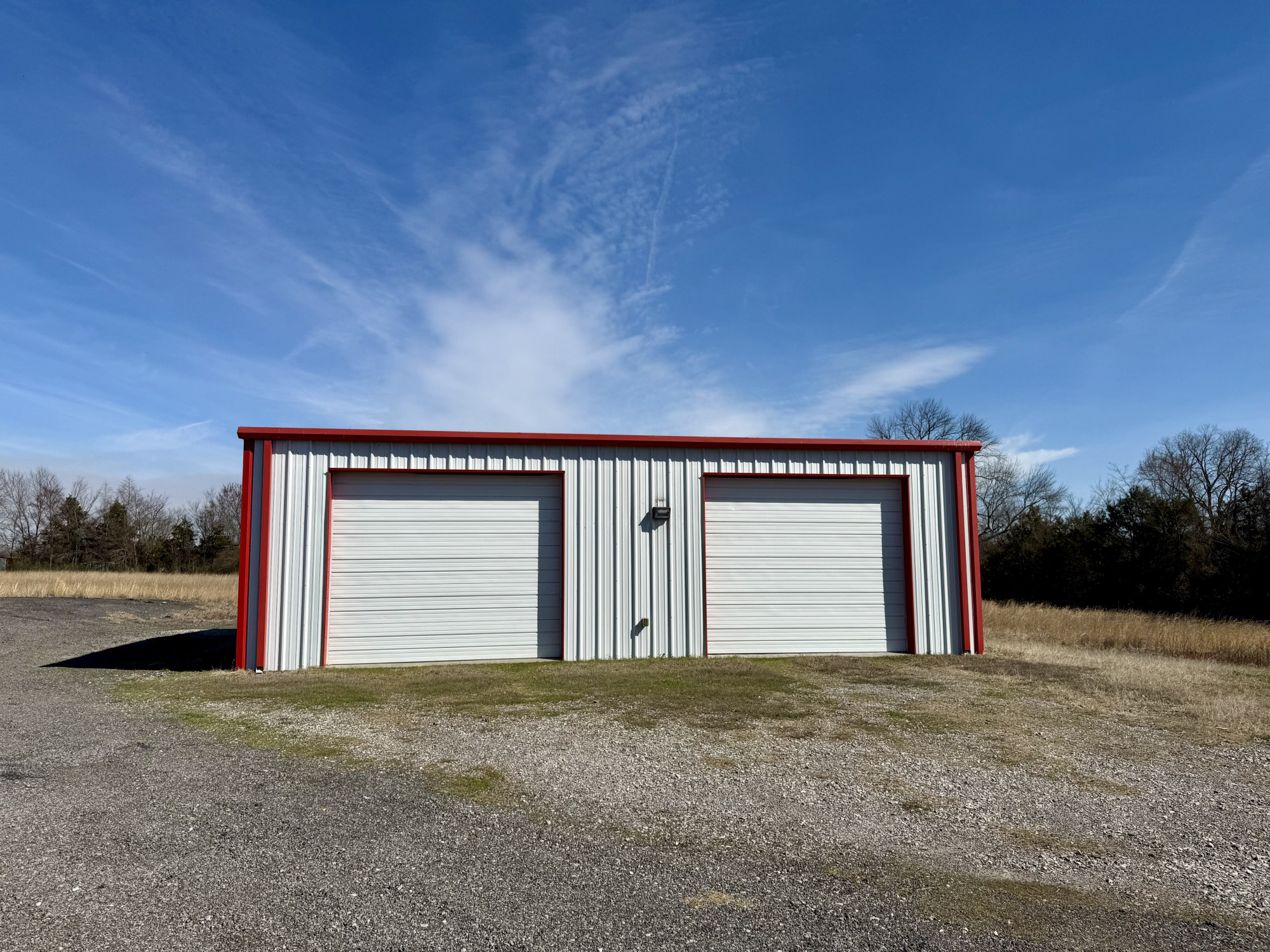
The “nearby fire station” Governor Sanders referenced in the official announcement of the land purchase is this building in the Vesta community of Franklin County. Inside are two pickup trucks outfitted with plastic water tanks. Photo courtesy of author
“The town hall meeting was just for show.”
On the evening of November 7, state officials convened in the gymnasium of Charleston High School for a town hall meeting with the citizens of Franklin County and their elected representatives. During the forum, county officials and residents—including Senator Stubblefield, Representative Jon Eubanks of Subiaco, and Senator Bryan King of Green Forest, as well as Rosemary Underwood and Don Sosebee—questioned the lack of transparency surrounding the project and challenged the governor’s claims that the site provided optimal access to infrastructure and a hearty workforce. They explained their worry about the possibility of pollution in their well water. “Mill Creek Mountain is known for its rocky underground terrain,” Underwood said. “If explosives are used in construction, they could damage nearby water wells . . . jeopardizing both water quantity and quality.” Wearing a suit and a cream-colored cowboy hat, Sosebee warned that the cost of building and maintaining a mega prison in a location with no resources to support it would impact every taxpayer in Arkansas. “I hate to see the great people of our great state have to pay for this thing for year after year after year . . . there will be no end to what the taxes will be.”
The town hall was a passionate showing of community solidarity, but the citizens were left dissatisfied. Members of the Arkansas Board of Corrections had few answers to questions about land and infrastructure studies. (They, too, had been left out of the site selection process, learning about the purchased land roughly two weeks ahead of the public.) Joe Profiri, the former corrections secretary who was fired by the board and who now works as an advisor to the governor, was intimately involved in the site selection. He also failed to provide evidence that the state had performed its due diligence prior to purchasing the land, noting simply that infrastructure upgrades would be required for the project regardless of the site selection. Profiri also attempted to explain the state’s lack of transparency by saying that officials hadn’t wanted to ignite a bidding war by revealing an interest in the Mill Creek Mountain property. No one could offer firm estimates about the cost of building and maintaining the largest-ever corrections facility in Arkansas. During her announcement, the governor had shied away from providing a budget for the prison’s construction, calling the cost “a little bit fluid,” though $470 million had been the estimated figure when the governor first announced her intent to increase the state’s corrections capacity in 2023. Comparable facilities in other states have cost more than double that budget.
It seemed to the people of Franklin County that state officials were not taking their concerns seriously. “I could tell that from their body language,” Underwood told me. “The town hall meeting was just for show.” She said that officials seemed to disengage as she spoke to them. “They would not meet my eyes.” Charlie Brown, a retired rancher who managed the prison site when the land belonged to Toby Breeden, said that no one who came to the town hall from the capital of Little Rock had arrived willing to listen. “Didn’t take long to figure out they done had their minds made up,” Brown said. “They weren’t really interested.” The following day, the Board of Corrections voted to accept the preemptively purchased land as the site for the planned mega prison.
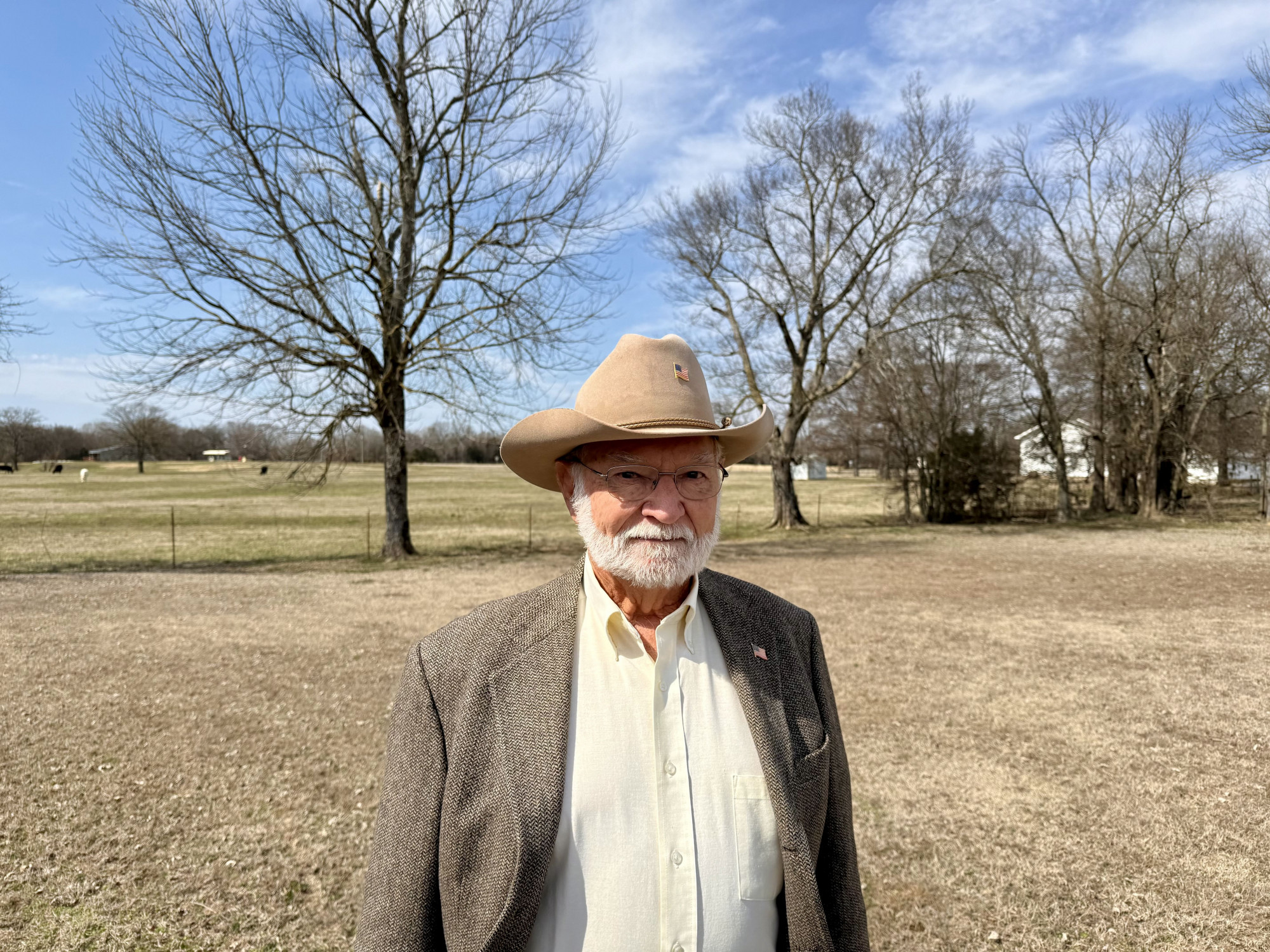
Charlie Brown, a retired rancher and Franklin County resident, opposes the prison. Photo courtesy of author
“Maybe they thought a couple thousand pages here and there was too much for us to read.”
The people of Franklin County began holding their own meetings. They organized into a collective called the Franklin County & River Valley Coalition and, later, a spin-off nonprofit called Gravel & Grit. They created websites, wrote blog posts, solicited input from advocacy groups focused on criminal justice reform, and began driving to Little Rock to participate in hearings, to ask more questions of officials who could not, or would not, give them answers. They also used the Freedom of Information Act (FOIA) to request all communications related to the planned prison in Franklin County. Through legal counsel, the governor, who had restricted the state’s FOIA laws in 2023, declared her own communications exempt from the requests, but a deluge of material arrived nonetheless. “We were shocked at some of the things that they turned over to us, like, without any bit of resistance whatsoever,” said Adam Watson, a Branch resident who moved to Franklin County from Texas with his wife, Taylor, a little over two years ago. Watson used to work in the legal field and has played a critical role in the community’s effort to get answers through FOIA requests. He wondered if hubris had anything to do with the state’s early acquiescence. “Maybe they thought a couple thousand pages here and there was too much for us to read,” he said.
What emerged from those thousands of documents was both baffling and clarifying. The questions everyone had been asking about infrastructure? Employees of the Department of Transformation and Shared Services (TSS), which was instrumental in the site selection process, had them too. In one email, sent to the governor’s advisor and former corrections secretary, Joe Profiri, on July 10, 2024, Anne Laidlaw, Director of the TSS Division of Building Authority, wrote: “I did drive to the site on Hwy 215 near Charleston, AR on Sunday. Access to the site is a challenge, and based on what I have learned from you in prior site assessments, I do not think it is viable.” Regarding water sourcing, an engineer at the Department of Health wrote to Shelby Johnson, Director of the TSS Division of Geographic Information Systems, “The amount that Riversouth Rural could supply to your site is unknown,” before referring Johnson to Jack Wells, who said he never heard from Johnson. In an email Johnson sent to colleagues about the site, he wrote, “Workforce numbers are not great, and accessibility is not great.”
Along with infrastructure issues, the FOIA documents revealed cost problems. Though the governor had neglected to define a budget for the prison’s construction, it had been clear to most that the $470 million estimate from 2023—when a plan for expansion was first announced—would not be sufficient. This fact was verified by a December 2023 memo obtained through FOIA, in which officials from the TSS Division of Building Authority wrote, “Based on preliminary estimates . . . the current budget will not deliver 3000 beds.”
Legislators, specifically senators Gary Stubblefield and Bryan King, pushed state officials to provide a realistic budget that accounted for the infrastructure hurdles that had been identified. At a February 12 meeting of the Board of Corrections, King said, “We have to be fiscally responsible. . . . We cannot go down a path where we do not know the price tag of what something’s going to cost.” Later that month, the state’s Budget Committee declined the governor’s request to appropriate $330 million (an amount held in restricted reserve funds) toward the prison’s construction. During that meeting, lawmakers had pressed again for the final budget and asked what expenses the $330 million would cover. Department of Corrections Secretary Lindsay Wallace said that she couldn’t answer these questions. Stubblefield and King said that appropriating funds without knowing the final cost of the project was an irresponsible use of taxpayer money. “[The budget] should have been done before we started this process, because this state cannot afford a $1.5 billion prison, and that’s what at least this is going to cost,” King said.
As it turned out, the state had been given an estimate of $1.2 billion by a North Little Rock architecture firm on August 12, 2023. The Arkansas Times reported this number, obtained through the Franklin County community’s FOIA requests, on February 28, the day after the budget committee’s refusal to appropriate money to the project. By March 3, a new estimate in the amount of $825 million had arrived from a California-based construction management firm that the state contracted in mid-October 2024. The same day, Senator Jonathan Dismang of Searcy filed a bill to appropriate $750 million for the prison’s construction. (The remaining $75 million needed to meet the new estimate would come from money that had been set aside by former governor Asa Hutchinson for an expansion to the North Central Unit at Calico Rock that the Sanders administration had declined to pursue.) On March 20, the Joint Budget Committee voted to move Dismang’s bill forward, despite concerns raised by various legislators about the lack of clarity around costs for infrastructure upgrades, mounting prices of construction materials, and the impacts of steel tariffs. Representative Jim Wooten of Beebe said, “We’re going to have to build roads. We’ll have to have a complete new water treatment facility, sewer system, and everything that goes along with that rural development area of the state, and forget the fact that the people up there do not want it.” Senator John Payton of Wilburn agreed, saying that, although he liked the idea of building a new prison, “I’m not sure that we made a wise business decision in where we’re going to put it.” He said the lack of budgetary planning prior to the land purchase “did destroy a lot of confidence in the people making the decision.” Senator Bryan King said that the $825 million estimate from the California construction management firm amounted to speculation. “These prison building companies . . . they provide just a cover letter, no details of the roads, no details of the water, no details of site preparation. . . . I’d trust Dracula running a blood drive before I would trust prison building companies on keeping their estimates.”
The $750 million appropriation must be approved by both the state Senate and the House of Representatives prior to any dispersal of funds. Adam Watson said that he and his fellow Franklin County citizens “look forward to a vote by the larger body when the legislature returns from recess and hope, at some point, that the voices of the people are considered in the process. . . . At the very least there’s enough admitted unknowns that they can’t put any confidence behind the estimate of $825 million.”
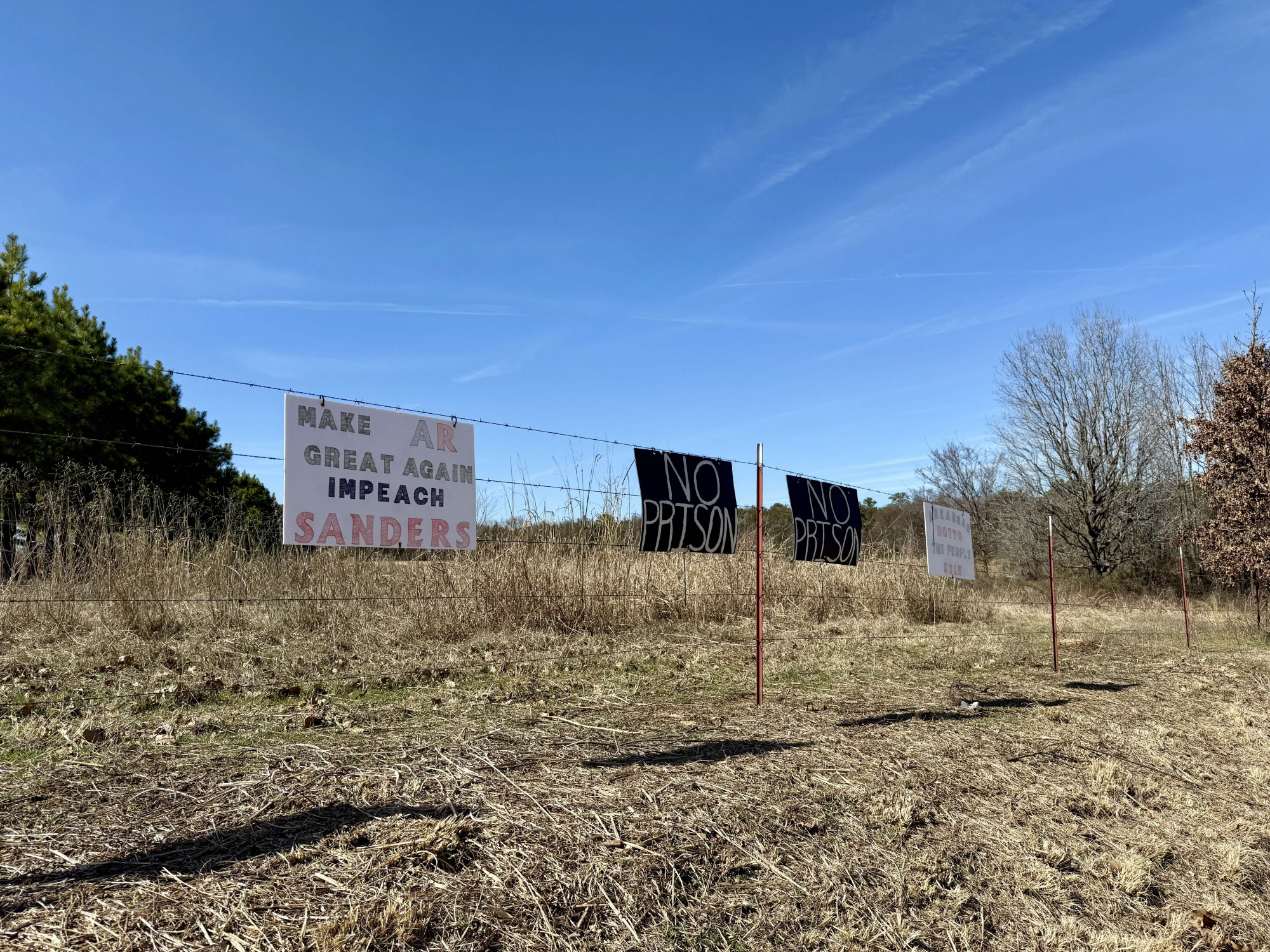
Photo courtesy of author
It does not offer the requisite workforce to staff eight hundred permanent positions.
The FOIA documents also confirmed that the Mill Creek Mountain property meets just two of the state’s criteria: it is not located within sixty miles of another Arkansas correctional facility, and it is greater than three hundred acres. What it is not is “relatively flat,” a specification outlined in internal documents as well as the state’s publicly available site assessment. Rather, the land is undulating, with elevation changes as great as 140 feet. The property does not afford, as the site assessment specifies, “proximity to emergency services and medical facilities.” It does not provide easy access to a landfill, wastewater treatment, or Interstate 40, which parallels the Arkansas River on its northern side. And it does not offer the requisite workforce to staff eight hundred permanent positions.
Natalie Cadena, a Fort Smith resident and the daughter of the poultry farmer who built his own water tower, has worked closely with Adam Watson to analyze and organize the FOIA documents. She reviewed an email containing a basic formula for manufacturing jobs, which had been submitted by a consultant of the state. Cadena noted that, to earn a 10/10 on the consultant’s scoring scale, a population size of 250,000 would be required to fill 500 manufacturing jobs. (The formula assumes that twenty percent of the workforce is suitable for manufacturing jobs, likely a higher percentage than is suitable for corrections positions.) A population size of 125,000 would offer 25 candidates per role and score a 4/10 on the consultant’s scale. A population size that offers fewer than 25 candidates per job would score a 1/10. Applying this formula to the 800 jobs required to staff the 3,000-bed prison, a population of at least 200,000 is needed to score above a 1/10 on the consultant’s scale. On the state’s site assessment, the population within a thirty-mile driving distance of the prison is listed as 167,500. Cadena also recognized that the labor pool identified in the site assessment—108,784 people—had been inflated. Though the state had determined that its labor pool would come from within a thirty-mile driving distance, the total workforce count seemed to factor in the full populations of Franklin, Crawford, Johnson, Logan, and Sebastian counties, all of which extend beyond the driving threshold. Notably, the majority of Johnson County sits outside of that boundary.
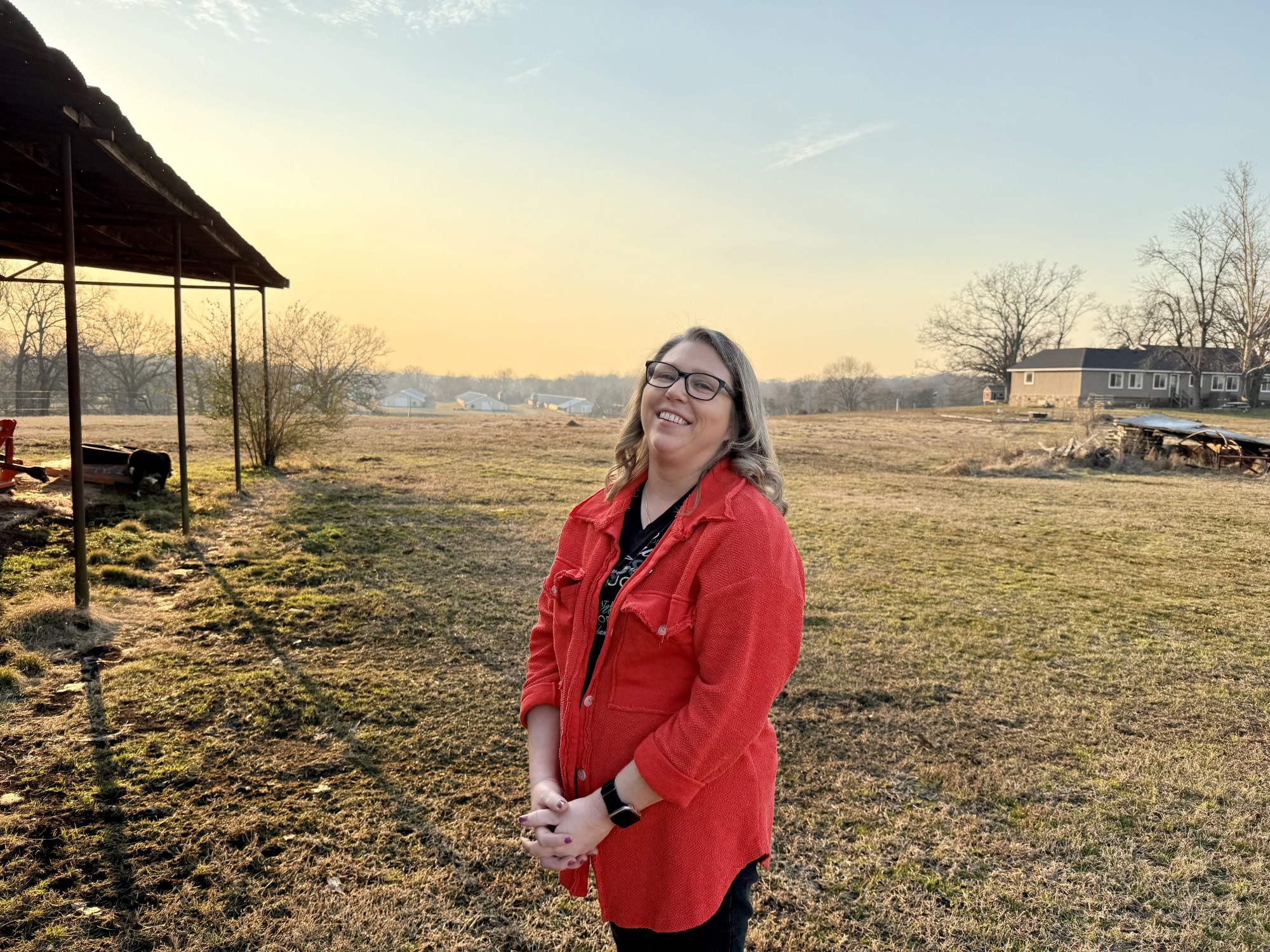
Natalie Cadena helped launch Gravel & Grit, a nonprofit organization fighting against the prison construction. Photo courtesy of author
“A prison has the ability to just, like, take over the entire DNA of everything around it.”
To the communities they go into, prisons are billed as economic drivers, as opportunities for recession-proof jobs and infrastructure upgrades—new roads crowded by hotels and big-box stores. This is why, so often, correctional facilities are built in economically depressed locales and why many residents welcome them. But research indicates that, while prisons do create jobs, the turnover in those jobs is high and local economies never see the promised boom. In fact, those who live closest to a prison typically experience declines in their property values—a side effect that is particularly worrisome to the people of Franklin County. Taylor Watson, the fundraising arm of the prison resistance nonprofit Gravel & Grit, said that she and her husband, Adam, lived near a federal prison south of Houston before relocating to Franklin County. “There wasn’t any town where we lived,” she said. “There was a gas station and a bar, and then, like, nothing else. . . . A prison has the ability to just, like, take over the entire DNA of everything around it.”
To Cadena, the Watsons, and many others in their community, the notion that the state’s prison project will benefit Franklin County resonates as especially out of touch. “They keep telling us, oh, we’re gonna love it, that we’re going to thank them someday for them forcing us to be a part of this,” Rosemary Underwood said. But Franklin County, with its 3.4 percent unemployment rate, is not the kind of economically desperate community that might respond to such narratives. It is, rather, a place where nearly seventy-four percent of families own their land, where people pass both their property and their agricultural ventures down through generations. Driving through the pastoral southern district, someone unfamiliar with rural living might assume that the absence of hotels and restaurants and shopping centers is a signal of financial hardship. But it is not a lack of money that makes life a little harder in this region of northwest Arkansas; it’s the work—the livestock and the acres upon acres of land that require a person’s attention. “You don’t come out here and just do nothing,” said Sara Jane Douglas, an Altus resident whose family is scattered all over Franklin and Sebastian counties. Her grandmother Sedalia has lived on the same land for most of her adult life and grew up just a few miles east, near Mill Creek Mountain. Now in her eighties, she still manages her cattle farm with the help of her children, grandchildren, and great-grandchildren, her nieces and nephews. This sharing of labor among family members is not unusual in Franklin County, where both hard work and family land are prized assets. “If you wanted it to be easy, you’d move to town,” Douglas said. “But when you live out here and you farm out here . . . it’s because you enjoy the work.”
The work—the pride that comes from physical labor—amounts to less frivolity, fewer dollars spent on things you can grow or make from scratch. Shannon McChristian’s father, Don Sosebee, acquired his three hundred acres over six decades and built his home himself from Tennessee lumber he ordered by the truckload. “To the outside world, Dad looks poor,” McChristian said. “He’s not.” Cadena and Adam Watson both described Franklin County as a place with “a lot of quiet money.”
Between their analysis of the state’s math and their knowledge of their region, Cadena and her fellow Gravel & Grit supporters cannot fathom any scenario in which the state could adequately staff a prison on Mill Creek Mountain. Historically, the Arkansas Department of Corrections has struggled to staff their existing facilities. Inmate overcrowding has also been a persistent problem that is expected to increase under the Protect Arkansas Act, which prioritizes lengthier incarceration terms and which went into effect in January. (The state’s incarceration rate is the third highest in the nation. Roughly sixty-seven percent of that population is not yet convicted, according to the Prison Policy Initiative.) Overcrowding and understaffing reached a crisis point in late 2023, when the governor, assisted by then-corrections secretary Joe Profiri, ordered that six hundred temporary beds be added to the state prison system. The Board of Corrections refused, saying that they could not responsibly add more beds at their current staffing levels, and later requested that the governor send National Guard members to help fill the void. The relationship between the governor and the Board of Corrections has been publicly chilly ever since, with the board filing suit against the governor’s office for circumventing the body’s authority.
According to the most recent data from the Department of Corrections, the state’s facilities had an average staff vacancy rate of 35.41 percent for security positions in December 2024. Some facilities, including East Arkansas, Grimes, Larry B. Norris, and McPherson, had vacancy rates over fifty percent. Amid these existing staffing problems throughout the state and the limited workforce available in Franklin County, officials have been exploring new recruitment strategies. Adam Watson told me that he had recently received new documents through FOIA that indicated the state’s interest in investing in law-enforcement programs at Arkansas Tech University’s Ozark campus to “create a pipeline” of workers for the 3,000-bed prison in Franklin County.
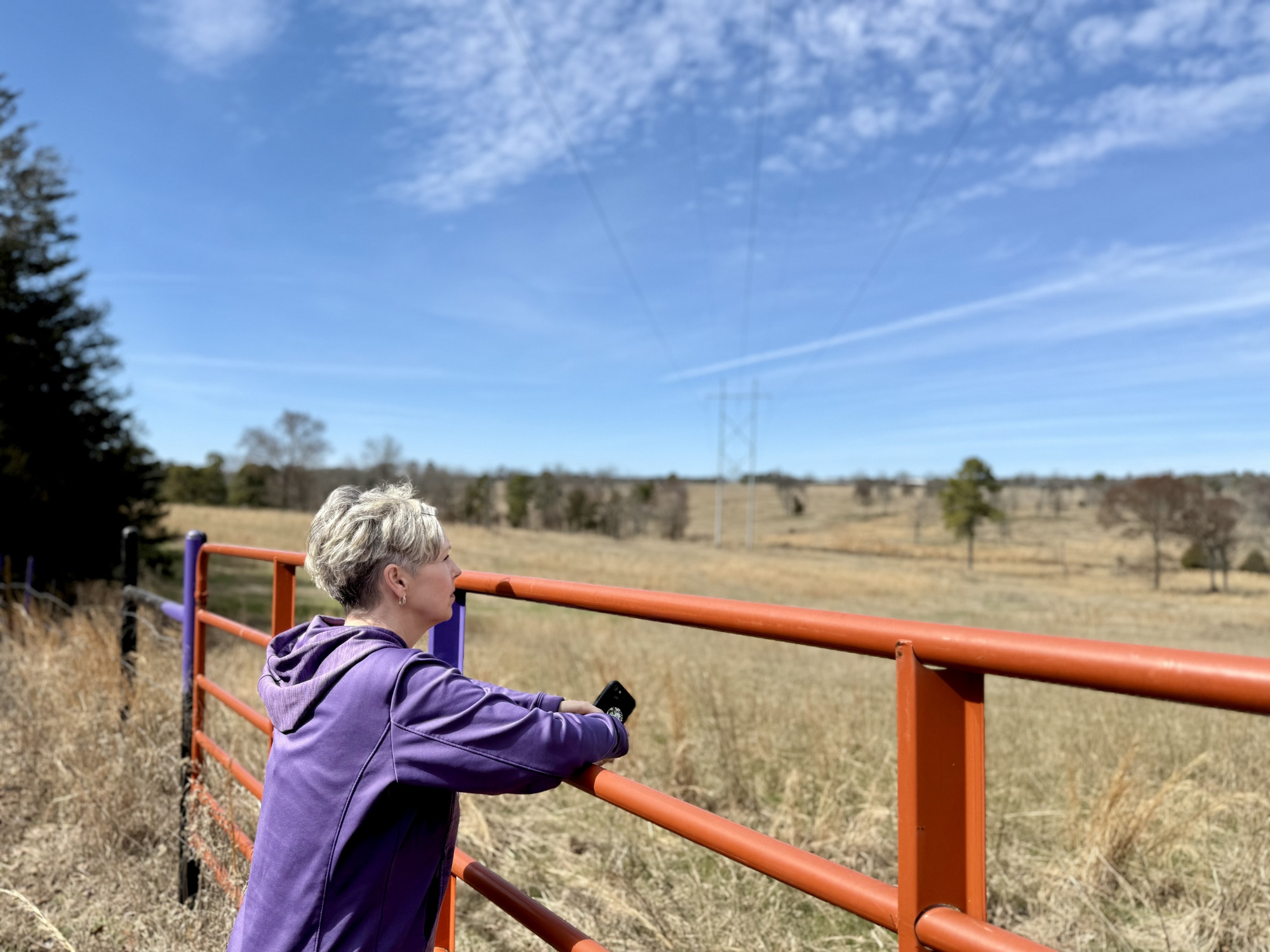
Shannon Sosebee McChristian grew up on land that shares a fence with the prison site. The state has marked the fence with purple paint, the universal ”No Trespassing” sign. Photo courtesy of author
“No matter what happens with the prison, I’ll be fighting this stuff forever.”
The documents obtained through FOIA appear to prove what locals have been saying since October 31, 2024: Mill Creek Mountain is a poor place to build a prison. They also indicate that the state did not perform adequate due diligence prior to spending taxpayer money to purchase the site, and that officials continue to ignore big questions as they demand funds nearing a billion dollars. Many Franklin County residents believe that state officials have displayed a disregard not just for their concerns about the project but for their very way of life. On October 31, presumably as news of local backlash reached state officials in Little Rock, Jonathan Duran, Deputy Director of the TSS Division of Geographic Information Systems, emailed a South Park clip titled “They Took Our Jobs” to his boss, Shelby Johnson. “Do you think a possible townhall meeting in Franklin County about the proposed state prison might go a little like this?” Duran wrote. The clip he shared mocks local resistance as redneck idiocy. “I think our group proves otherwise,” Natalie Cadena said. (Duran was quickly removed from the prison project after the Arkansas Times revealed his misstep.)
But if there is any impulse to revel in the self-satisfaction of being right, the people of Franklin County haven’t indulged it. “The fight,” as they call their efforts to stop the prison—efforts that have continued to involve their presence at legislative hearings and expanded to include a chili cookoff and a dance-party fundraiser called “Jailhouse Rock”—is trundling ahead because the state is not backing down. In fact, the governor’s office responded to criticism by putting more pressure on lawmakers to fund the prison. On March 28, as legislators prepared to return from a week-long break, Governor Sanders published an op-ed in the Arkansas Democrat-Gazette urging them to “finish the job.”
In another community, in another county, in another state, people might have given up. To know why the citizens of Franklin County haven’t requires an understanding of a shared value system that transcends modern politics and eschews American trends toward isolated and lonely living. About 17,500 people live in Franklin County. Such a small population means very little voting power, a fact that has caused some to wonder if Sanders chose their location because any backlash there won’t matter to her reelection. Those who do vote tend to choose conservative candidates—4,127 people voted for Sanders in the 2022 gubernatorial race, which accounted for nearly seventy-six percent of the county’s turnout. But the dominant philosophy is more libertarian than MAGA. During my visit, people spoke of land as their legacy, of the self-determination they had needed to grow it and to keep it. They talked about the quietude of their sprawling homesteads even as they shared details about every neighboring family within eyeshot. “We like some room, some breathing room,” Don Sosebee said, “and we like to know our neighbors.”
The region has a history of bucking political systems, too, most notably in 1954, when the Charleston school district became the first in the South to integrate. The move was guided by the liberal local attorney Dale Bumpers, who later defeated Mike Huckabee, Sanders’ father, to become the Governor of Arkansas and who remains a posthumous hero for many in Franklin County. (When they discuss the impracticality of Mill Creek Mountain as a site for the state’s first mega prison, some locals joke that Sanders chose it out of filial spite for Dale Bumpers.)
On several occasions, Franklin County’s resistance to the prison has been dismissed as NIMBYism. The acronym stands for Not in My Back Yard and is associated with local ire over housing and other development projects. Research into NIMBY attitudes shows that higher-density areas tend to welcome new development, while low-density areas often resist it. “I guess we’re part of that,” Rosemary Underwood said. “We’re only two and a half miles from it, and so that’s pretty much in our backyard.” But NIMBYism is too simple, too diminishing of all that is at stake on Mill Creek Mountain—the water supply and the land values, the neighborly culture and the night sky. Light pollution from the prison is among the myriad impacts citizens have considered. “Those places, they just glow all the time,” Adam Watson said, “And you can see it from miles away.”
NIMBYism also fails to capture the shifting of minds that has occurred in this tight-knit community. Watson said that most people he engages with are eager to understand the impacts of a mega prison well beyond the bounds of their backyards. Not many believe that Arkansas should be spending so much money locking people up or that a new prison ought to be constructed anywhere in their state. Shannon McChristian has become a vocal opponent not just of the Franklin County prison but of Arkansas’s entire carceral system. She explained that learning about mass incarceration was something she had long managed to avoid living in the state’s River Valley region. “The stuff that I’ve learned over the last three or four months has changed me,” McChristian said. “And no matter what happens with the prison, I’ll be fighting this stuff forever.”
Updated on April 1, 2025 at 3:15 p.m. — On April 1, the bill to appropriate $750 million toward prison construction in Franklin County failed on the Senate floor.
Updated on April 2, 2025 at 10:30 a.m. — This story was updated to include the total population within a thirty-mile driving distance of the prison site.



